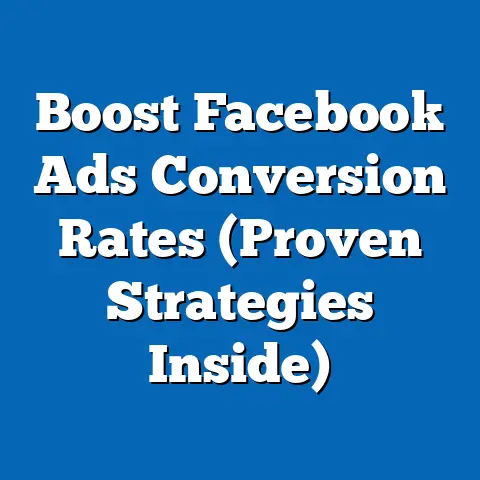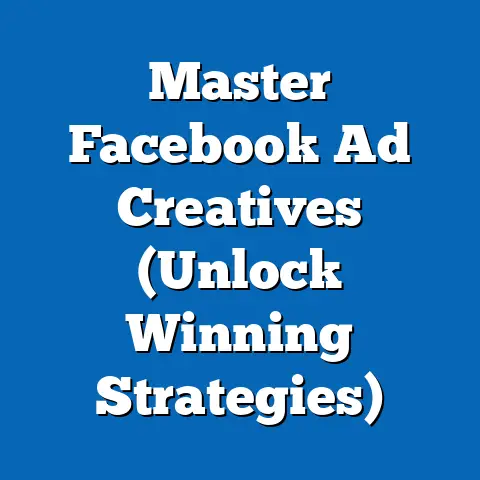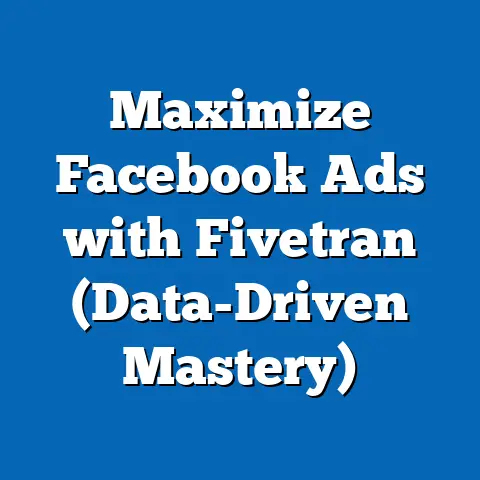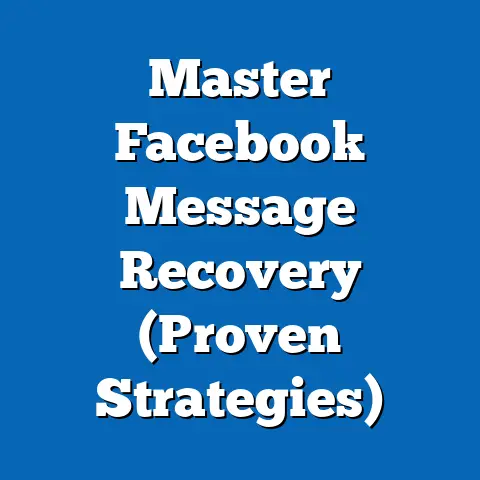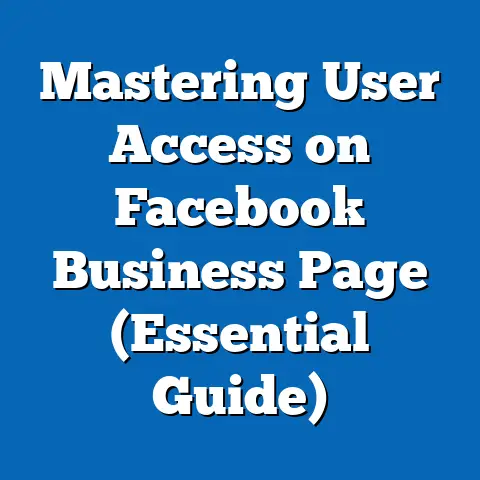Are All Facebook Ads Legit? (Truth Revealed)
Have you ever scrolled through your Facebook feed and stopped, captivated by an ad promising unbelievable results or a product at a price that seems too good to be true? I know I have. In fact, I once almost fell for a scam offering a “free” high-end camera, only to realize it was a phishing scheme designed to steal my personal information. This experience made me realize how crucial it is to understand the legitimacy of Facebook ads.
Facebook has become a powerhouse in the advertising world. With billions of active users, it’s a prime platform for businesses of all sizes to reach their target audiences. The platform’s advanced targeting capabilities, diverse ad formats, and relatively low cost compared to traditional advertising channels have made it indispensable for many marketers. However, this widespread adoption also means that less scrupulous individuals and organizations have found their way onto the platform, hoping to exploit unsuspecting users.
In this article, I will walk you through the ins and outs of Facebook advertising. I’ll start by defining what Facebook ads are and exploring their various formats. Then, I’ll delve into the anatomy of a legitimate ad, highlighting the key features that distinguish it from a fraudulent one. I’ll also expose the common tactics used in scams and fake ads, providing you with red flags to watch out for. Finally, I’ll examine Facebook’s advertising policies and share real-world user experiences to give you a complete picture of the landscape. By the end of this guide, you’ll be well-equipped to make informed decisions and stay safe while engaging with Facebook ads.
Understanding Facebook Ads
Facebook ads are paid messages that businesses use to reach specific audiences on the Facebook platform, including Instagram (since Meta owns both). These ads appear in users’ news feeds, sidebars, and within Facebook’s Marketplace, among other places. Unlike organic posts, which are only seen by followers of a business page, ads can be targeted to users based on a wide range of criteria, including demographics, interests, behaviors, and even custom audiences built from website traffic or email lists.
There’s a huge variety of ad formats available, each designed to achieve different marketing objectives. Here’s a quick rundown of some of the most common types:
- Image Ads: These are simple ads featuring a single image and accompanying text. They’re great for showcasing products or services in a visually appealing way. I’ve found that high-quality images and concise, compelling copy are key to making image ads effective.
- Video Ads: Video ads can be more engaging than image ads, allowing you to tell a story, demonstrate a product, or capture attention with motion. Short, attention-grabbing videos tend to perform best on Facebook.
- Carousel Ads: Carousel ads allow you to display multiple images or videos within a single ad unit, each with its own headline, description, and link. This format is ideal for showcasing a range of products or highlighting different features of a single product. I’ve used carousel ads to showcase multiple angles of clothing items and have seen great results.
- Collection Ads: Similar to carousel ads, collection ads are designed for e-commerce businesses. They feature a main image or video along with a selection of related products that users can browse and purchase directly from the ad.
- Lead Ads: Lead ads are designed to collect contact information from users without them having to leave the Facebook platform. They include a pre-filled form that users can submit with just a few taps, making it easy for businesses to generate leads.
- Instant Experience Ads: These are full-screen, mobile-optimized experiences that open when a user clicks on an ad. They can include a combination of images, videos, text, and interactive elements, providing a rich and engaging experience.
The effectiveness of Facebook ads is undeniable. According to Statista, Facebook’s advertising revenue in 2023 reached over \$134 billion, highlighting the platform’s significant role in the digital advertising ecosystem. A study by HubSpot found that Facebook ads have an average conversion rate of around 9.21%, which is significantly higher than many other digital advertising channels.
Businesses use Facebook ads for a variety of purposes, including:
- Brand Awareness: Increasing brand visibility and recognition among a target audience.
- Lead Generation: Collecting contact information from potential customers.
- Website Traffic: Driving traffic to a website to increase sales or engagement.
- Sales: Directly selling products or services through the Facebook platform.
- App Installs: Encouraging users to download and install a mobile app.
- Event Promotion: Promoting events and driving attendance.
For example, a local restaurant might use Facebook ads to promote a new menu item and drive traffic to their website, while an e-commerce business might use carousel ads to showcase their latest collection of products and drive sales. A software company might use lead ads to collect contact information from potential customers interested in a free trial. I’ve personally used Facebook ads to promote my own online courses, targeting users based on their interests and professional backgrounds, and have seen a significant increase in enrollments as a result.
Key Takeaway: Facebook ads are a versatile and powerful tool for businesses of all sizes. Understanding the different ad formats and their intended purposes is the first step in creating effective and legitimate advertising campaigns.
The Anatomy of a Legitimate Facebook Ad
What exactly makes a Facebook ad “legitimate”? It boils down to transparency, professionalism, and a clear value proposition. A legitimate ad is one that accurately represents the product or service being offered, provides clear and honest information, and respects the user’s experience.
Here are the key features that characterize a legitimate Facebook ad:
- Clear Branding and Logos: A legitimate ad will clearly display the brand name and logo of the business or organization running the ad. This helps users easily identify the source of the ad and build trust. I always look for a recognizable brand logo to help me quickly assess an ad’s legitimacy.
- Professional Design and Quality Visuals: Legitimate ads typically feature high-quality images or videos that are professionally designed and visually appealing. This demonstrates attention to detail and a commitment to providing a positive user experience. Blurry, pixelated images or poorly designed graphics are often red flags.
- Transparent Descriptions and Calls-to-Action: The ad copy should clearly and accurately describe the product or service being offered, including its features, benefits, and any limitations. The call-to-action should be clear and direct, telling users exactly what they should do next (e.g., “Shop Now,” “Learn More,” “Sign Up”). Vague or misleading descriptions are a sign of a potentially illegitimate ad.
- Accurate Contact Information: Legitimate ads should include accurate contact information for the business or organization running the ad, such as a website URL, email address, or phone number. This allows users to easily reach out with questions or concerns. The absence of contact information is a major red flag.
- Privacy Policy and Terms of Service: Legitimate ads that collect personal information should link to a privacy policy and terms of service, explaining how the information will be used and protected. This demonstrates a commitment to transparency and user privacy.
Targeting and audience segmentation also play a role in the legitimacy of an ad. A legitimate ad will be targeted to an audience that is likely to be interested in the product or service being offered. For example, an ad for a new line of athletic shoes might be targeted to users who have expressed an interest in running, fitness, or sports. If an ad is targeted to an audience that seems completely irrelevant, it may be a sign that the ad is not legitimate.
Consider this example of a well-designed Facebook ad:
Company: Nike
Ad Format: Image Ad
Visual: A high-quality image of a person running on a trail wearing the latest Nike running shoes.
Copy: “Experience the ultimate in comfort and performance with the new Nike Air Zoom Alphafly NEXT%. Designed for speed and endurance, these shoes will help you reach your personal best. Shop Now and get free shipping on orders over \$100.”
Call-to-Action: “Shop Now”
Branding: Clear Nike logo and branding throughout the ad.
Targeting: Users interested in running, fitness, and sports.
This ad is legitimate because it features clear branding, high-quality visuals, a transparent description of the product, a clear call-to-action, and is targeted to an audience that is likely to be interested in running shoes.
On the other hand, an illegitimate ad might look something like this:
Company: (Unknown)
Ad Format: Image Ad
Visual: A blurry, low-quality image of a luxury car.
Copy: “Get a brand new luxury car for just \$500! Limited time offer! Click here to claim your prize!”
Call-to-Action: “Click Here”
Branding: No clear branding or logo.
Targeting: (Unknown)
This ad is highly suspicious because it lacks clear branding, features a low-quality image, makes an unrealistic offer, and has a vague call-to-action. It’s likely a scam designed to collect personal information or trick users into paying for something they’ll never receive.
Key Takeaway: A legitimate Facebook ad is transparent, professional, and targeted to the right audience. By paying attention to these key features, you can easily distinguish between legitimate opportunities and potential scams.
Identifying Scams and Fake Ads
Unfortunately, not all Facebook ads are created equal. Scammers and fraudsters have found ways to exploit the platform to deceive unsuspecting users. It’s crucial to be aware of the common tactics they use and the red flags to watch out for.
Here are some common characteristics of fraudulent Facebook ads:
- Unrealistic Offers: These ads often promise unbelievable results or offer products at prices that seem too good to be true. Examples include “Get rich quick” schemes, miracle cures, or luxury items being sold at drastically reduced prices. Remember the old adage: if it sounds too good to be true, it probably is. I once saw an ad promising to double my investment in just 24 hours – needless to say, I stayed far away!
- Poor Grammar and Spelling Errors: Scam ads often contain numerous grammatical errors and spelling mistakes. This is because they are often created by individuals or organizations who are not native English speakers or who simply don’t care about quality. Legitimate businesses typically invest in professional copywriting and proofreading.
- Lack of Contact Information or Transparency: Fraudulent ads often lack clear contact information for the business or organization running the ad. They may not include a website URL, email address, or phone number, making it difficult for users to verify their legitimacy or reach out with questions or concerns.
- Suspicious URLs or Links: Be wary of ads that link to suspicious URLs or websites. These websites may contain malware, phishing scams, or other malicious content. Always check the URL before clicking on a link to make sure it’s legitimate. Hovering over the link can often reveal the actual destination URL.
- Pressure Tactics: Scammers often use pressure tactics to try to get users to act quickly. They may claim that an offer is “limited time only” or that there are only a few items left in stock. This is designed to create a sense of urgency and prevent users from taking the time to do their research.
- Requests for Personal Information: Be extremely cautious of ads that ask for sensitive personal information, such as your social security number, bank account details, or credit card information. Legitimate businesses typically don’t need this information upfront.
Here are some real-life examples of scams that have been perpetrated through Facebook ads:
- Phishing Scams: These scams involve creating fake ads that mimic legitimate businesses or organizations. The ads link to fake websites that are designed to steal users’ login credentials or personal information. I almost fell victim to one of these, where an ad claimed to be from my bank and asked me to “verify” my account details.
- Fake Product Sales: These scams involve selling fake or counterfeit products through Facebook ads. The ads often feature high-quality images of the products, but the actual products that are shipped to customers are of poor quality or are completely different from what was advertised.
- Investment Scams: These scams involve promising high returns on investments with little or no risk. The ads often target inexperienced investors and use high-pressure tactics to get them to invest their money.
- “Free” Gift Card Scams: These scams involve offering “free” gift cards in exchange for completing surveys or providing personal information. The ads often link to fake websites that are designed to collect users’ data.
If you encounter a Facebook ad that seems suspicious, here are some steps you can take:
- Don’t Click on the Ad: Avoid clicking on the ad or visiting the website it links to.
- Report the Ad to Facebook: You can report the ad to Facebook by clicking on the three dots in the upper right corner of the ad and selecting “Report Ad.”
- Do Your Research: If you’re interested in the product or service being offered, do your research to verify the legitimacy of the business or organization running the ad. Check their website, read reviews, and look for any red flags.
- Be Skeptical: Always be skeptical of offers that seem too good to be true.
- Protect Your Personal Information: Never share sensitive personal information with unknown or untrusted sources.
Key Takeaway: By being aware of the common tactics used in scams and fake ads, you can protect yourself from becoming a victim. Always be skeptical of unrealistic offers, poor grammar, and suspicious links. When in doubt, do your research and report any suspicious ads to Facebook.
Impact of Facebook’s Advertising Policies
Facebook has implemented a comprehensive set of advertising policies and guidelines designed to protect users and promote legitimate ads. These policies cover a wide range of topics, including prohibited content, targeting restrictions, and ad formatting requirements.
Here are some of the key areas covered by Facebook’s advertising policies:
- Prohibited Content: Facebook prohibits ads that promote illegal products or services, discriminate against individuals or groups, contain misleading or deceptive content, or violate intellectual property rights. This includes ads that promote drugs, weapons, hate speech, or fake news.
- Targeting Restrictions: Facebook restricts the targeting of ads based on certain sensitive categories, such as race, ethnicity, religion, sexual orientation, and health conditions. This is designed to prevent discrimination and protect user privacy.
- Ad Formatting Requirements: Facebook has specific requirements for the formatting of ads, including image size, text length, and call-to-action placement. These requirements are designed to ensure that ads are visually appealing and easy to understand.
- Misleading or Deceptive Practices: Facebook prohibits ads that use misleading or deceptive practices to trick users into clicking on them or purchasing products or services. This includes ads that make false claims, use clickbait headlines, or hide important information.
- Personal Attributes: Ads must not contain content that asserts or implies personal attributes. This is designed to protect user privacy and prevent discrimination.
Facebook reviews and approves ads before they go live on the platform. This process involves a combination of automated systems and human reviewers.
- Automated Systems: Facebook uses automated systems to scan ads for violations of its advertising policies. These systems can detect prohibited content, suspicious links, and other red flags.
- Human Reviewers: Ads that are flagged by the automated systems are then reviewed by human reviewers. These reviewers assess the ads to determine whether they comply with Facebook’s advertising policies.
If an ad violates Facebook’s advertising policies, it will be rejected and will not be allowed to run on the platform. Advertisers who repeatedly violate Facebook’s advertising policies may have their ad accounts suspended or terminated.
Facebook’s advertising policies play a crucial role in filtering out illegitimate ads and protecting users from scams and fraud. However, the system is not perfect, and some fraudulent ads may still slip through the cracks. That’s why it’s important for users to be vigilant and report any suspicious ads they encounter.
For example, I’ve personally reported ads that were promoting weight loss pills with unrealistic claims and misleading before-and-after photos. These ads were eventually taken down by Facebook, demonstrating the effectiveness of the reporting system.
Facebook is constantly working to improve its advertising policies and enforcement mechanisms. The company invests heavily in technology and human resources to detect and remove fraudulent ads from the platform. However, the fight against scams and fraud is an ongoing battle, and it requires the cooperation of both Facebook and its users.
Key Takeaway: Facebook’s advertising policies are designed to protect users and promote legitimate ads. While the system is not perfect, it plays a crucial role in filtering out illegitimate ads. Users can help by reporting any suspicious ads they encounter.
User Experiences and Case Studies
To truly understand the impact of Facebook ads, both positive and negative, it’s helpful to hear from real users who have encountered them. These experiences can provide valuable insights and lessons learned.
Here are some narratives from real users who have encountered both legitimate and fraudulent Facebook ads:
- Sarah, a small business owner: “I’ve had great success using Facebook ads to promote my handmade jewelry. I target my ads to women who are interested in fashion and accessories, and I’ve seen a significant increase in sales as a result. The key is to create high-quality ads with clear branding and a compelling offer.”
- John, a college student: “I almost fell for a scam on Facebook that was advertising ‘free’ iPhones. I clicked on the ad and was taken to a website that asked for my credit card information to cover shipping costs. Luckily, I realized it was a scam before I entered my information.”
- Maria, a stay-at-home mom: “I’ve found some great deals on Facebook ads for baby clothes and toys. I always check the reviews of the seller before making a purchase to make sure they’re legitimate.”
- David, a retired teacher: “I was targeted by an ad on Facebook that was promoting a ‘miracle cure’ for arthritis. The ad made some pretty outrageous claims, and I knew it was too good to be true. I reported the ad to Facebook.”
Here are some case studies of businesses that have successfully utilized Facebook ads:
- Warby Parker: This online eyewear retailer has built a successful business by using Facebook ads to drive traffic to its website and generate sales. Warby Parker uses a combination of image ads, video ads, and carousel ads to showcase its products and target its ideal customers.
- Dollar Shave Club: This subscription-based razor company has used Facebook ads to acquire new customers and build brand awareness. Dollar Shave Club’s ads are known for their humor and irreverence, which has helped them stand out in a crowded market.
- Airbnb: This online marketplace for vacation rentals has used Facebook ads to drive bookings and attract new hosts. Airbnb uses a combination of image ads and video ads to showcase its properties and target travelers who are looking for unique accommodations.
Here are some case studies of businesses or individuals who have fallen victim to scams on Facebook:
- A small business owner who lost thousands of dollars to a fake marketing agency: This business owner was contacted by a marketing agency that promised to help them generate leads through Facebook ads. The agency charged the business owner thousands of dollars but failed to deliver any results.
- An individual who had their identity stolen after clicking on a phishing ad: This individual clicked on an ad that was designed to look like it was from their bank. The ad linked to a fake website that asked for their login credentials. The individual entered their credentials and had their identity stolen.
The lessons learned from these experiences are clear:
- Do Your Research: Before clicking on an ad or making a purchase, do your research to verify the legitimacy of the business or organization running the ad.
- Be Skeptical: Always be skeptical of offers that seem too good to be true.
- Protect Your Personal Information: Never share sensitive personal information with unknown or untrusted sources.
- Report Suspicious Ads: If you encounter a Facebook ad that seems suspicious, report it to Facebook.
- Read Reviews: Check the reviews of the seller before making a purchase to make sure they’re legitimate.
Key Takeaway: Real-world user experiences and case studies provide valuable insights into the impact of Facebook ads. By learning from these experiences, you can make smarter decisions and protect yourself from scams and fraud.
Conclusion
Navigating the world of Facebook ads can feel like traversing a minefield. On one hand, there’s the potential for incredible reach, targeted marketing, and significant ROI. On the other, there’s the ever-present risk of encountering scams, fake offers, and deceptive practices.
Throughout this article, I’ve aimed to equip you with the knowledge and tools you need to confidently navigate this landscape. We’ve explored the anatomy of legitimate ads, identified the red flags of scams, examined Facebook’s advertising policies, and learned from real-world experiences.
Here are the key takeaways to remember:
- Transparency is Key: Legitimate ads are transparent about who they are and what they’re offering.
- Professionalism Matters: Legitimate ads are well-designed and professionally written.
- Skepticism is Your Friend: Be skeptical of offers that seem too good to be true.
- Research is Essential: Do your research before clicking on an ad or making a purchase.
- Reporting Helps: Report any suspicious ads you encounter to Facebook.
By applying these principles, you can make smarter decisions and protect yourself from scams and fraud. Remember, the power is in your hands to discern between legitimate opportunities and deceptive practices.
As you continue to navigate your Facebook ad experiences, stay vigilant, stay informed, and stay safe.
Call to Action
Have you encountered a particularly effective or particularly deceptive Facebook ad? Share your experiences in the comments below! Let’s learn from each other and build a community of informed and empowered Facebook users. You can also share this article on social media to help spread awareness and protect others from scams and fraud.

